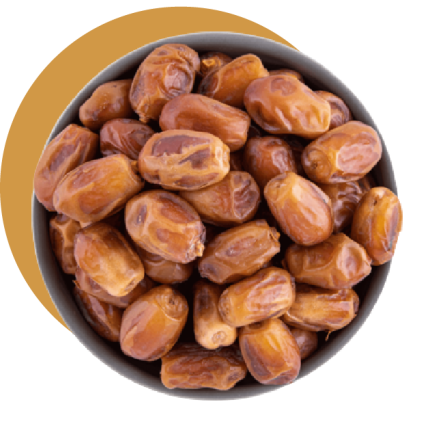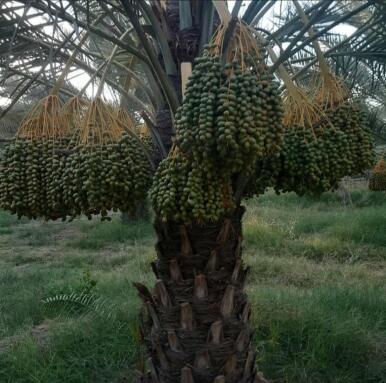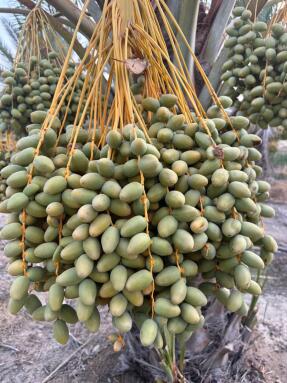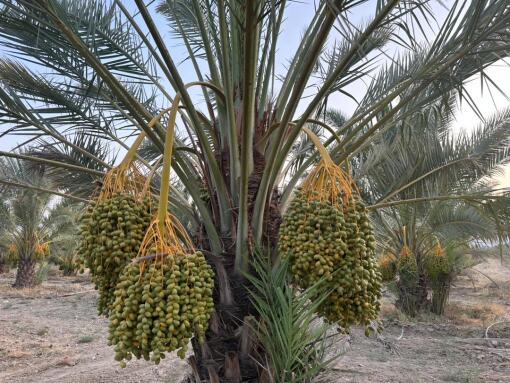
Zahedi Dates
Zahedi dates are classified as dry dates. In some areas, it is known as semi-dry varieties, in some parts of the country it has been named as Ghasab. The shape of this fruit is oval and its end is quite thin and sharp. The fruit is yellow in the unripe stage, and light brown in fresh date stage, and in the stage of date, it is brown nearly red to light yellow.
Zahedi Dates is one the dry varieties of the date in most regions of Iran, however, in some regions it is known as a semi-dried date. The date is produced in Khuzestan, Fars, Bushehr and Kermanshah provinces, but the main production is in a region called Bushehr Province.

One of the most suitable dates for export in Iran is Zahedi date, which is also known as Qasab and it is called Zahdi in Arabic. This date is one of the best-selling dates in Iran and other countries due to its very simple storage place and maintaining conditions and its many fans. Iranian Zahedi dates are meaty and delicious and, as they are considerably less sweet than other date varieties available, they are particularly suited to those who aren't hugely keen on sweet tasting things.
The shape of this fruit is elongated oval and its end is quite narrow and sharp. The fruit turns yellow in the Kharek stage, light brown in the wet stage and pale reddish to yellow in the date stage. It is very high quality dates type and is suitable for storage and easy transportation and is considered as an export cultivar.
This date is one of the dried dates and is classified in this part. Among the benefits of consuming Zahedi dates due to having copper, magnesium, manganese and selenium and having abundant antioxidants, we can mention preventing gastrointestinal cancer, improving heart health, and removing cholesterol from heart cells.
The growth place of zahedi dates
Zahedi dates are one of the types of dried dates in the world. The cultivation of Zahedi dates is very large in Iran, so that it is cultivated from the western south regions of the country such as Kermanshah (Qasr-e-Shirin), Khuzestan, Bushehr, Hormozgan province and south of Fars province.
The hot and dry climate of these areas has provided very good conditions for the growth of the best specimens of these dates in these regions. Thousands of tons of dates are harvested annually in Iran, of which a large volume in domestic consumption and a large volume are prepared for export and exported to neighboring countries and Europe.
Iran is one of the best country for planting and harvesting this crop due to its Various climate conditions, and fortunately the harvest of this crop in Iran is very suitable.
Iranian Zahedi dates can be kept at normal room temperature for around 18 months - 2 years with intermittent fumigation. Zahedi dates are highly durable and the fact that they do not require refrigeration makes shipping them easy.
Harvest time of zahedi dates
Zahedi date palm, like other palms, is planted almost in August and April is the time of pollination or the so-called local time of roasting. After that, from September to October, the harvest time of dates begins.
The fruit of Zahedi palm is yellow in Kharek. Over time, as the weather gets warmer, the fruit reaches a moist state and changes color to yellowish brown or light brown. After the wet state, the final stage is called the date. Following these changes, the brown color of Zahedi dates changes to reddish to pale yellow, depending on each region.
The benefits of zahedi dates
Iranian Zahedi dates contain a variety of minerals (such as potassium, magnesium and protein), vitamins (such as vitamin A, vitamin B complex and vitamin C) and sugars (such as fructose). Their high folate content makes them an effective way of increasing blood circulation. The calorie content of the Zahedi date is made up mostly of simple carbohydrates, some proteins and very little fat. 100g of dried Zahedi dates contains is made up of 70% carbohydrates, 2.2% protein and 0.6% fat and contains around 300 calories. 100g of fresh Zahedi dates, in comparison, contains around 160 calories. Zahedi dates can even help to prevent from various health conditions and diseases; they can help to cure indigestion, prevent anaemia, improve memory and vision. What's more, they also contain only a trace amount of fat - leading them to be considered a low-fat, nutritious food. It should be noted, however, that overindulging on date fruit can cause weight gain due to their excessive sugar content (mostly simple sugars).
Iranian Zahedi dates can be eaten directly out-of-hand or, for a twist, they can be seeded and stuffed with variety of different foodstuffs for different flavour combinations. They make a delicious addition to cereal, puddings, bread, cakes, cookies, ice cream or candy bars. Surplus dates from production are not wasted, being processed into cubes, paste, spread, powder (date sugar), jam, jelly, juice, syrup, vinegar and alcohol. Other products produced using Zahedi dates include palm sugar, chocolate, fruit bars and certain soft drinks. They are also a popular choice amongst diabetics because of their low and natural sugar.













